|
|

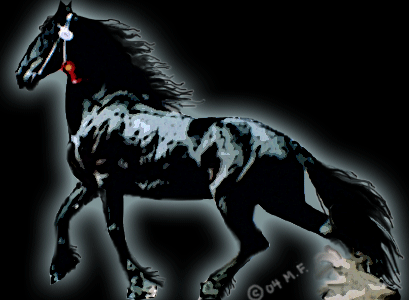

TEXT NOT DIRECTLY FROM FHANA IS COPYRIGHTED, BY MELISSA FISCHBACH - No use without permission
This page provides information on:
Friesian market prices, history, breed influences, confirmation, traits, the judging or kuering's, Ster, model and preferent status, & reading your registration papers
For Information on; Training, Growth, Choosing & Buying a Friesian, recommendations, plus misconceptions & myths. Please go under "Training Q & A"
For Approved Stallions please go under "U.S. Approved Stallions". For documentary films about the breed please go under "merchandise"
Average Market Values. PLEASE NOTE Price's can very drastically, depending on: bloodlines, training, soundness and seller motivation. These average market Prices are based on Sales By the US Friesian Referral Service.
Weanlings to 1 year olds $7,000-12,000
Colt or filly 2-3 year olds $9,000-19,000
Geldings/Stallions undersaddle 3+ yrs $12,000-28,000
Stallions Under saddle 3+ years $17,000-30,000
Star Geldings $18,000-26,000
Mares 3+ years $14,000-23,000
Star Mares $25,000-$40,000
Preferant Mares no quotes, very rarely for sale, would depend on age
Model Mares $40,000 -100,000
Qualified Stallions $200,000-600,000
Approved Stallions (qualified on offspring) $300,000-600,000
Why are Friesians horse so expensive? In 1970 there were only 5 Stallions in the world. In 1991 there was only 800 Friesians in the United States.
In 2002 there was an estimated 2000 Friesians in the U.S. Though they are an increasingly popular breed, Friesians are a still considered a rare and endangered species.
Please note there is no difference in price for show Friesians vs. non-show Friesians
Want to know how to read your Dutch papers? -CLICK IMAGE TO ENLARGE
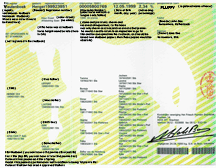
CLICK HERE TO VIEW common DUTCH/ENGLISH Horse word translations.
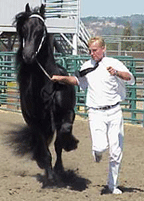 CLICK HERE TO LEARN HOW TO SHOW YOUR HORSE AT A KUERING CLICK HERE TO LEARN HOW TO SHOW YOUR HORSE AT A KUERING
Breed influences
The Friesians are a cold-blooded horse. The original foundation Friesians can be traced back to a cold-blooded Native forest horse. The remains of such a horse had been unearthed in the Fries an area of North Holland. During times of war,
Friesians were influenced and refined with barb blood. Later during the crusades with battle mobility in mind and Andalusian blood was added. The Friesian in its turn has provided the foundation blood for many European breeds.
Some samples of which are: The Shire, Gelderlander, Olderburger, Fell ponies, Old English Blacks, Dutch Warmbloods, The Holestiner, to name a few and here in American they are thought to have been the ancestors of the Morgan horse.
Confirmation and Build Types
There are theoretically three basic variations of the Friesian horse. Lightweight, Medium weight and heavyweight. Though not always distinguishable, I would venture to say that most Friesians are considered a medium weight horse.
During the judging, judges do not discriminate against any certain type but strive to keep the all styles of Friesians alive.(see photos at bottom of page for build samples)
Height:
15.2 hands to 16.0 hands on average(1 hand =4 inches) though some reach 17.hands, the Dutch judges prefer them to be within the average range.
Color:
Always black, white markings are undesirable. a few white hairs or very small star are allowed on the forehand.
Head:
The Friesian head can vary from fine, long and baroque, to short and delicate. Dished faces are not desirable.
Ears:
The ears are small and alert.
Neck:
The neck is the upright and crested with a graceful arch and narrow throatlatch.
Shoulder:
The shoulder is long, sloping and the set well into the back.
The withers are well rounded.
Body:
The body is compact and strong.
Hindquarters:
The hindquarters are strong with a marked down word slope of the croup. The tail is low set.
Legs:
The Legs are short, strong and thick with large clean joints.
Hoofs:
The hoof is hard, hearty and is a of blue (black) Horn.
Hair:
The mane tail and forelock are created of long thick, sometimes curly hair. Thick hair or feathering on the fetlock area of the lower legs is one of the main breed characteristics.
Movement:
The Friesians trot with extreme power and action, bending well and deep at the joints. Steps are high and long with lot of "air time'.
The walk is straight, forward and springy.the canter is lively with a strong pushing power from the hindquarters this creates a thrusting, jumping canter.
Temperament:
The temperament of the Friesian horse is loyal, Willing, placid and cheerful. Friesians are very people oriented and highly intelligent with an uncanny ability to retain knowledge.
Spooking:
Friesians tend to spook much like a cat, they stand stock-still puffing themselves up the look "big".
Friesians do not tend to bolt but they can sometimes spin slowly in a circle always coming back around to face what they are afraid of.
Uses:
The Friesians strength and willingness makes them suitable for use as Workhorses, (plowing, pulling)
Their good looks and proud bearing makes them excellent for Carriage and harness. Their agility and temperament provide great dressage and riding Horses. (Friesians are not often used for jumping due to their heavy stature.)
Life span/traits:
Friesians have a long life span, some stallions in their 20s still provide the highest sperm count. Friesians in their late teens can be easily recognized due to the gray hair that grows around their eyes and head which later spreads to the legs.
Friesians, being native to Friesland, which is surrounded by water, are by nature water babies. (Exercise caution when crossing streams and rivers or you might find yourself going for an unwanted swim!)
Friesians are thick skinned and therefore not prone to accidents however they have a very high pain tolerance so keep in mind when you're Friesian displays symptoms of sickness or lameness the injury or illness is most probably fairly advanced.
Friesians enjoy shoving you with their nose, this is not a personality fault. This is the way Friesians say I love you, refrain from reprimanding your horse or you may lose his or her loyalty.
(You can however, shove them back.)
Friesians bond closely with their owners and will follow them through a scary situation based on trust alone.
All Dutch registered Friesians are registered to queen of Holland.
Friesians take longer to develop than most Horses, due to their larger bone structure. Most Friesians are not fully developed until they reach the ages of four to six years. It is advisable to wait until your horse has reached its full growth and development before asking for too much work.
Feeding/care:
Friesians are an extremely hardy horse, they can work and maintain good condition on moderate ration's.
Friesians do not require special care. The Friesian's thrive on regular attention and pasture or turnout.
Ride-ability:
Friesians are uncomplicated to ride. Though typically forming a bond with their owner they can be ridden by any number of people without being ruined, they are commonly used for, pleasure riding, driving and dressage.
They were never bred with jumping in mind therefore do not have the appropriate build for it. Friesians do have a slow heart rate since no Arabian or Thoroughbred blood is in the line. They do not get a second wind. Therefore they are unsuited to disciplines of speed or endurance.
Friesian gaits are comfortable yet large and thrusting.
(It's like riding a horse in slow motion.) Ones with more dressage type movement can be bouncier.
Choosing your Friesian:
(Please look under Friesian training on this website)
Versatility:
The Friesian is extremely versatile it can excel in most disciplines. They are fine to ride Western, English, drive and are fun on trail.
They are also prized as circus horses.
Breeding/Inbreeding:
All Friesians are inbred to some extent. Registration papers all have an inbreeding coefficient listed. When choosing you stallion it is important to figure in the inbreeding % of the resulting foal. Foals are allowed to have an inbreeding percentage of up to 12% though a lower number is ideal on mares.
US mares verse Holland Mares: The benefits to purchasing your mares from Holland is that you can bring in mares that are not directly related to Stallions here in the U.S. ( though this does not apply to all mares) you then have a larger breeding pool to choose from with lower inbreeding % on your produced offspring.
The following section regarding the judging and registration, is based on the rules and regulations of FPS (the Friesian paarden stambook) and FHANA (the Friesian Horse association of North America, an affiliation.)
Any one wanting more information on Rules and Regulations are encouraged to join one of the clubs and/ or visit www.FHANA.com
The practices of branding and tongue tattoos are no longer in use.
The Judging/keurings:
The judging or keurings are annually held at sites designated by FHANA (the Friesian horse association of North America) FHANA provides members with information on attending and participating in annual judging.
Horse's are presented by category based on their age and separated by gender. The foals are judged when they are under a year old. At three or four years the Horses return and attempt to receive a status as a Ster mare or star gelding. Premiums or preemie's are given to each foal and each mare and gelding. There are four preemie categories with one or first preemie being the highest. The fourth category or no preemie is awarded to foals with white markings, of poor quality confirmation, serious defective faults or to high of an inbreeding percentage.
Foals receiving a no preemie will still be entered in the foal book.
Preemie ribbon color's are as follows:
First premium ribbon/orange
Second premium ribbon/red
Third premium ribbon/white
No premium Foals/no ribbon
No Premium/Studbook ribbon yellow
Premiums given to foals will most likely change when they returned to be judged star status.
Scoring:
Movement is 60 percent of your overall score and confirmation is 40 percent.
All Friesians receive a microchip and or tongue tattoo when they are entered into the foal book. All horses 3 or older when entering into the studbook are hot branded with an F on the left side of the neck.
Ster(or Star):
Ster status is awarded to an estimated 10% of all Friesian's mostly 3+ year old mares and gelding's who display ideal confirmation and movement. (Although there is a category for older mares and geldings and you are allowed to try your horse for Ster status several times)
Horses that receive Ster are also given a new premium.
You can have either a first preemie Ster or a second preemie Ster.
Horses that at this stage that receive a 3rd preemie, do not make Ster, but are entered into the stud book.
Initially until 2002 all horses that made Ster, geldings or mares were branded with an FS on the left side of the neck, all horses that only made it into the studbook were branded with an F only.
Preferent:
Preferent is given to Ster mares or Stallions who have had at least four offspring make Ster.
Model:
Model is given to mare's or stallion's who have undergone a strict evaluation of personality, movement, confirmation and performance under Saddle and pulling a Carriage.
About Approved Dutch Breeding Stallions
Stallion Approval is a very strict and rigorous process Stallions to be considered for approval are first judged in hand at a local Kuering. They are judged on movement, temperament, and their bloodlines are thoroughly examined to see if their lineage is prestigious enough to be considered for a Stallion candidate.
Stallions that pass this examination are then taken to a Stallion testing center for 10 weeks in Dracthen, Netherlands. There the stallions are trained to ride and drive, they are tested and evaluated on movement trainability, performance, personality, and soundness. They undergo though veterinary exams and bloodtesting. Out of the yearly 15-30 stallions attending the Drechten test center. Only 3-7 stallions pass each year. The stallions that Pass are given a 5 year breeding permit. After and during, the permitted 5 years of the new stallions breeding seasons, the 20 oldest offspring of this stallion will be judged on performance, 10 off the oldest offspring will be picked at random by the stud book and the final 10 my be chosen by the stallion owner. The judges will also evaluated the foals from the stallion. Here in the U.S. the stallion's foals are the ones evaluated because of the great distance and trouble it would take to bring 20 offspring of one stallion to a central location. If the newly approved stallions offspring after the 5 years grace period do not show premium scores in performance, confirmation and temperament. That stallions breeding permit will be revoked and that stallion will no longer be approved for breeding and must be gelded.
ANY MARE THAT IS BRED TO A NON APPROVED STALLION,the Offspring of such a breeding cannot be registered and the papers of the mare and of the non approved stallion may be revoked from the Dutch registry. The breeder would also not longer be a member in good standing
FRIESIAN BODY TYPES (Examples for terms commonly used)
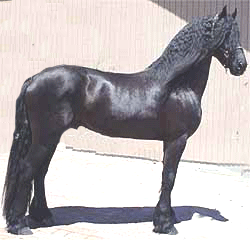
'Modern' Style (Light) Build
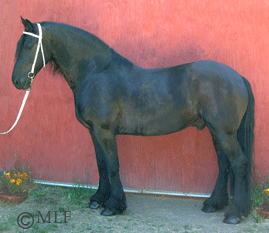
'Baroque' Style (Medium) Build
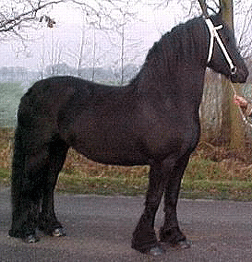
'Old Classical' Style (Heavy) Build
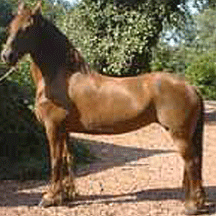
Rare Chestnut or 'fox Friesian' CLICK HERE for info on Chestnuts
THE FRIESIAN HORSE HISTORY
COPYRIGHTED BY Melissa Fischbach
The Friesian Horse, native to the Netherlands in Holland, is known in its native county as a 'Jack of all Trades'. You can see Friesians being used for everything from plowing the fields, to taking the family to church in a high stepping carriage, to performing well in most any discipline. The History of the Friesian can be traced back to a cold-blooded native forest horse; the remains of such a horse have been unearthed in the Fries area of North Holland. During the 16th and 17th centuries, Friesians were influenced and refined with barb blood, which added the small head and the craning neck. Later during the crusades with battle mobility in mind Andalusian blood was added, this gave Friesians their trade mark high knee-action and more speed undersaddle. The Friesian horse having been kept free from influence of the English Thoroughbred and the Arabian is not considered a warm-blood but is a cold-blood Medium weight draft breed.
During the last two centuries, with the help of monks from monasteries in Friesland, the Friesian breed has been kept pure from outside influence
The Friesian breed is very distinguishable, always solid black, with high knee action, elegant performance, trade mark feathered feet and a glorious long mane and tail ( that is not allowed to be cut). The breed is known for its steadfast loyalties to their owners, a kind and good natured, people-oriented personality and a hardy constitution with good strong bones and hoofs.
In the 18th and 19th centuries, the "black pearls of Friesland" were highly sought after as a trotting race horse for the short distance of (325 m). These trot races, ridden bare-back were very popular and held annually in Fries land villages and towns. Prestigious winners of these races were awarded a 'golden whip'. Later Festivities also included a special Ring race with the traditional Friesian "sjees". (a white 2-wheeled cart) manned by a farmer and his wife dressed in traditional Friesian Heritage costumes The men would Drive the Sjees at a brisk trot and the women would attempt to spear a hanging finger sized ring. Reenactments of this historical Sport can still be seen today.
The Friesian horse has provided the foundation for many European breeds some samples of which you may recognize: The Shire, Gelderlander, Olderburger, Fell ponies, , Dutch Warmbloods and Holestiners, to name a few. Friesians were sought after for many prestigious stud farms. During 16th-18th centuries It was known that Hungarian King Louis II of France preferred to ride a heavy Friesian stallion, there were Friesian stallions in the stables of Don Juan of Austria, Prince George William of Prussia, the Danish stud at Frederiksborg and the stud at Salzburg Germany. The queen of Holland still keeps a stable of these fine horses and to this day all Friesians are registered to the crown.
Until the beginning of this century Friesian horses were imported to England for use to pull hearse coaches in London. As early as 1625 Friesian horses were being imported into what later would become the United States of America. The First 'official' registered Friesians were imported to the US in the 1970's. Today you can see this bred excelling in many disciplines: Circus, Dressage, Saddleseat, Carriage Driving, Combined Driving and Movies.
The "Het Friesch Paarden Stamboek"( FPS) in Holland supervises the maintenance and improvement of the Friesian horse throughout the world. Friesians here the in the US are monitored by a sister registry to the 'FPS' known as 'The Friesian Horse Association Of North America' or (FHANA). The Friesian Government though history has made many regulations in order to safeguard good breeding, cross breeding with a Friesian horse is forbidden by the Dutch registry. Due to strict breeding privileges, there are less then 100 approved breeding stallions in the world, here in the US we have approximately 18.
Though these horses may be know for their beauty a Friesian horse owner knows, they are treasured for there temperament and quickly become and inseparable part of the Family, one you will be left to wonder how you never did without.
|
|


![]()






















 CLICK HERE
CLICK HERE


